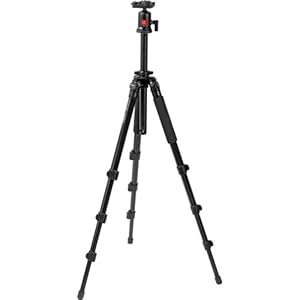Ask most people what they want in a good tripod for shooting landscapes and general outdoor photography and they’ll probably say Carbon Fiber. There’s a reason for this, and not just because CF is sexy. Carbon fiber offers excellent strength to weight ratio and good vibration damping, which is why they build mountain bikes and fighter jets out of the stuff.
Of course, the tradeoff is that carbon fiber is more expensive than aluminum, so when it comes to tripods, most of them cost well over three to four bills, sometimes over a thousand dollars if you want a high end Gitzo.
However, you don’t have to melt your credit card in order to get a decent carbon fiber tripod; here are 3 good, budget models that cost under $250. There are other OK models out there, but in my research, these are the best ones that fall into the “affordable but not cheap” category. If you’re looking for an even more affordable, yet quality tripod, check out my review from the other day, 5 Budget Tripods for Outdoor & Landscape Photography.
1. Manfrotto 190CXPro4 4-Section Carbon Fiber Tripod
 In my mind, the best budget carbon fiber tripod around is the Manfrotto 190CXPro4. It’s not as light as some ultra light tripods, but it will hold a heavier camera/lens setup. With a max load limit of 11 lbs, it will steadily support all but the heaviest camera/lens combos.
In my mind, the best budget carbon fiber tripod around is the Manfrotto 190CXPro4. It’s not as light as some ultra light tripods, but it will hold a heavier camera/lens setup. With a max load limit of 11 lbs, it will steadily support all but the heaviest camera/lens combos.
Derived from the 190XPROB, which won the American Photo Editor’s Choice award, the 190CXPro4 uses the same Q90 Quick Center Column that allows it to swing into a horizontal position.
The 4 flip lock legs can be arranged in any one of four angles for wide versatility of placement. Extending to 54″, weighing 2.9 lbs, and closing to 19.8″, the Manfrotto 190CXPro4 is a great lightweight tripod that offers excellent stability at a very reasonable price. ($249.)
2. Slik Pro 634CF 4-Section Carbon Fiber Tripod
 Slik makes great budget tripods; my first tripod was a Slik and I think that they’re great legs for the money.
Slik makes great budget tripods; my first tripod was a Slik and I think that they’re great legs for the money.
The Slik Pro 634CF ($259) breaks the two pound mark, weighing only 1.8 lbs without head. It’s listed as holding 8.8 lbs of camera gear, but people say that it’ll hold 11 lbs find. Max height on the screw lock legs is 44.7″, and the reversible center column allows for extremely low angle and macro shooting.
Travel photographers, take note: The Slik Pro 634CF closes down to only 18″ long when folded. That’s makes it an awesome budget tripod choice for backpacking or world hopping.
3. Vanguard Alta Plus 255CT Carbon Fiber Tripod
 At its current price of only $289 (currently only $169 at B&H), the Vanguard 255CT costs under half as much as some super high end Gitzo tripods. It’s lighter than most of the Manfrotto models, and it gets great reviews.
At its current price of only $289 (currently only $169 at B&H), the Vanguard 255CT costs under half as much as some super high end Gitzo tripods. It’s lighter than most of the Manfrotto models, and it gets great reviews.
I got to check it out for myself at PhotoPlus last year, and after playing around with the legs and locks for a minutes, it seems like the 225CT is built pretty well. With 5 screw lock leg sections, the legs close down to only 15.6″ and the whole thing only weighs just over 3.6 lbs w/o head.
The Vanguard 255CT is sturdy enough for a mirrorless camera setup, and up to medium weight DSLR and lens gear, but it’s probably not the one you want if you’re shooting a lot with a bigger, heavier lens or a pro body.
Support This Site: If you do decide to grab some new legs, please consider clicking through these links. It doesn’t cost you anything extra and it helps compensate me for the time and effort that it takes to run this site. Thanks! -Dan
[iframe]<iframe style=”width:120px;height:240px;” marginwidth=”0″ marginheight=”0″ scrolling=”no” frameborder=”0″ src=”//ws-na.amazon-adsystem.com/widgets/q?ServiceVersion=20070822&OneJS=1&Operation=GetAdHtml&MarketPlace=US&source=ss&ref=ss_til&ad_type=product_link&tracking_id=danhbaisadvph-20&marketplace=amazon®ion=US&placement=B0015MHY6K&asins=B0015MHY6K&linkId=OFCO5TMS67PMTRWE&show_border=true&link_opens_in_new_window=true”>
</iframe><iframe style=”width:120px;height:240px;” marginwidth=”0″ marginheight=”0″ scrolling=”no” frameborder=”0″ src=”//ws-na.amazon-adsystem.com/widgets/q?ServiceVersion=20070822&OneJS=1&Operation=GetAdHtml&MarketPlace=US&source=ss&ref=ss_til&ad_type=product_link&tracking_id=danhbaisadvph-20&marketplace=amazon®ion=US&placement=B0043XPGOA&asins=B0043XPGOA&linkId=TN2IW6IM4A4VYHS2&show_border=true&link_opens_in_new_window=true”>
</iframe><iframe style=”width:120px;height:240px;” marginwidth=”0″ marginheight=”0″ scrolling=”no” frameborder=”0″ src=”//ws-na.amazon-adsystem.com/widgets/q?ServiceVersion=20070822&OneJS=1&Operation=GetAdHtml&MarketPlace=US&source=ss&ref=ss_til&ad_type=product_link&tracking_id=danhbaisadvph-20&marketplace=amazon®ion=US&placement=B001HBIYJU&asins=B001HBIYJU&linkId=7A67GY5Q6MERHLCF&show_border=true&link_opens_in_new_window=true”>
</iframe>[/iframe]
[iframe]<iframe width=”120″ scrolling=”no” height=”240″ frameborder=”0″ border=”0″ src=”http://mer54715.datafeedfile.com/widget/aff_widget_prdt_generate-2.0.php?aff_num=6746&aff_net=1&widget_num=5889&sid=” marginheight=”0″ marginwidth=”0″></iframe>[/iframe]


 The
The  My very first tripod was a Slik (I think it was the 444 Sport), and it looked a lot like this, minus the padded legs. It served me for many years, in fact it’s the tripod that held my N90 when I made my famous
My very first tripod was a Slik (I think it was the 444 Sport), and it looked a lot like this, minus the padded legs. It served me for many years, in fact it’s the tripod that held my N90 when I made my famous  Want Manfrotto quality in a simple, budget design?
Want Manfrotto quality in a simple, budget design? 













 So what’s the best lens for shooting portraits?
So what’s the best lens for shooting portraits?









 How to Become a Pro Photographer
How to Become a Pro Photographer















